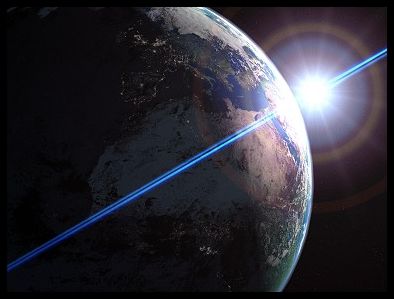

|
Astronomy 161
An Introduction to Solar System Astronomy
Prof. Scott Gaudi
|
Lecture 6: Daily & Annual Motions
Key Ideas:
Daily Motions
- Reflection of the Earth's Daily Rotation
- Circumpolar Stars
Annual Motions
- Reflection of the Earth's Orbital Motion
- Ecliptic: The Path of the Sun
- Zodiacal Constellations
- Solstices & Equinoxes
Daily Motions
Objects in the sky appear to rise in the East and set in the West each
day. This apparent daily motion is a reflection of the Earth's rotation
about its axis.
- Earth rotates once a day (24 hours)
- The sense of rotation is Eastward
- Facing North, rotation is towards the Right.
Apparent Paths
The Apparent Paths of objects are parallel to the Celestial
Equator.
Their orientation depends on your latitude:
- At Equator: perpendicular to the horizon
- At Poles: parallel to the horizon
- Mid-Latitudes: Tilted by (90º–Latitude)
In Columbus: we are at 40º N, so the paths are tilted by 50 degrees
from the horizon.
Circumpolar Stars
Any star closer than your latitude to your visible celestial pole (north
or south) will always be above your local horizon.
These are the Circumpolar Stars
- Ursa Major, Ursa Minor, & Draco are circumpolar
constellations as seen from Columbus
The opposite pole's circumpolar stars never rise above your horizon.
- Ursa Major never rises for latitudes south of about 40° S
Summary of Daily Motions:
Daily Motions of celestial objects reflect the Earth's
daily rotation about its axis:
- Celestial objects to appear to rise in the East and set
in the West.
- Apparent daily paths are parallel to the Celestial
Equator.
- The inclinations of these paths relative to the horizon
depends on the observer's latitude.
- Circumpolar objects are those always above or below the
local horizon.
Annual Motion of the Sun
Over the course of a year, the Sun appears to move a little towards the
East each day as seen with respect to the background stars. This daily
eastward drift is <1° per day (there are 365 days in a year, but
only 360° in a circle).
This apparent motion is a reflection of the Earth's annual orbit
around the Sun.
The Ecliptic
The Ecliptic is the apparent path of the Sun relative to
the stars.
- Great Circle projected onto the Celestial Sphere
- Tilted by approximately 23.5° from the Celestial Equator
This tilt is called the Obliquity of the Ecliptic
The Obliquity of the Ecliptic varies between 21.2 and 24.5° with
a roughly 41000 year period:
- Now it is 23° 26' 16.85"
- In 2000 it was 23° 26' 21.42"
The Zodiac
As the Sun moves along the Ecliptic as seen from Earth, it passes
through 12 ancient constellations known as the Zodiac.
- Many date from Babylonian times.
- These are familiar from astrological lore: Aries, Pisces,
Aquarius, Capricorn, Sagittarius, Scorpius, Libra, Virgo,
Leo, Cancer, Gemini, and Taurus.
The Zodical Constellations can be used as a kind of an astronomical
calendar:
- See which Zodiacal constellation is the highest (on your celestial
meridian) at midnight.
- The Sun is in the opposite constellation.
Solstices
Solstices occur when the Sun is at its maximum northern and southern
declination. The word Solstice is derived from the Latin words
"sol sistere" = "sun" and
"stand still".
Solstices occur twice a year in June and December:
- Summer Solstice: Maximum northern declination of
the Sun (June).
- Winter Solstice: Maximum southern declination of
the Sun (December).
Equinoxes
Equinoxes occur when the Sun crosses the Celestial Equator. Derives
from the latin "equinoctis" = "equal
night".
Equinoxes occurs twice a year, during March and September.
- Vernal Equinox: Sun crosses the Celestial Equator moving
North (occurs in March)
- Autumnal Equinox: Sun crosses the Celestial Equator moving
South (occurs in September)
Length of the Day
The length of the day depends on the location of the Sun along the
Ecliptic.
Vernal & Autumnal Equinoxes:
- Occur in March and September, respectively.
- The Sun rises due East and sets due West.
- Day and Night have equal lengths (12 hours each).
Summer Solstice:
- Occurs in June
- The Sun rises in the Northeast, and sets in the Northwest
- Day is longer than Night in the Northern Hemisphere
- Day is shorter than Night in the Southern Hemisphere
Winter Solstice:
- Occurs in December
- The Sun rises in the Southeast, and sets in the Southwest
- Day is shorter than Night in the Northern Hemisphere
- Day is longer than Night in the Southern Hemisphere
Summary of Annual Motions:
Annual Motions reflect the Earth's orbit around the Sun:
- The Ecliptic: Sun's path relative to the stars.
- The Obliquity of the Ecliptic: 23.5°
- Constellations of the Zodiac along the Ecliptic.
- Equinoxes: Sun crosses the Celestial Equator.
- Solstices: Sun at maximum North & South declination.
- Length of the day depends on the location of the Sun along the
Ecliptic.
Return to [
Unit 2 Index
|
Astronomy 161 Main Page
]
Copyright © Scott Gaudi, All Rights
Reserved.

